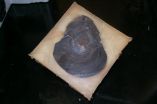(Press-News.org) Duck-billed dinosaurs that lived within Arctic latitudes approximately 70 million years ago likely endured long, dark polar winters instead of migrating to more southern latitudes, a recent study by researchers from the University of Cape Town, Museum of Nature and Science in Dallas and Temple University has found.
The researchers published their findings, "Hadrosaurs Were Perennial Polar Residents," in the April issue of the journal The Anatomical Record: Advances in Integrative Anatomy and Evolutionary Biology. The study was funded through a grant from the National Science Foundation.
Anthony Fiorillo, a paleontologist at the Museum of Nature and Science, excavated Cretaceous Period fossils along Alaska's North Slope. Most of the bones belonged to Edmontosaurus, a duck-billed herbivore, but some others such as the horned dinosaur Pachyrhinosaurus were also found.
Fiorillo hypothesized that the microscopic structures of the dinosaurs' bones could show how they lived in polar regions. He enlisted the help of Allison Tumarkin-Deratzian, an assistant professor of earth and environmental science, who had both expertise and the facilities to create and analyze thin layers of the dinosaurs' bone microstructure.
Another researcher, Anusuya Chinsamy-Turan, a professor of zoology at the University of Cape Town, was independently pursuing the same analysis of Alaskan Edmontosaurus fossils. When the research groups discovered the similarities of their studies, they decided to collaborate and combine their data sets to provide a larger sampling. Half of the samples were tested and analyzed at Temple; the rest were done in South Africa.
"The bone microstructure of these dinosaurs is actually a record of how these animals were growing throughout their lives," said Tumarkin-Deratzian. "It is almost similar to looking at tree rings."
What the researchers found was bands of fast growth and slower growth that seemed to indicate a pattern.
"What we found was that periodically, throughout their life, these dinosaurs were switching how fast they were growing," said Tumarkin-Deratzian. "We interpreted this as potentially a seasonal pattern because we know in modern animals these types of shifts can be induced by changes in nutrition. But that shift is often driven by changes in seasonality."
The researchers questioned what was causing the dinosaurs to be under stress at certain times during the year: staying up in the polar region and dealing with reduced nutrition during the winter or migrating to and from lower latitudes during the winter.
They did bone microstructure analysis on similar duck-billed dinosaur fossils found in southern Alberta, Canada, but didn't see similar stress patterns, implying that those dinosaurs did not experience regular periodic seasonal stresses. "We had two sets of animals that were growing differently," said Tumarkin-Deratzian.
Since the Alaska fossils had all been preserved in the same sedimentary horizon, Fiorillo examined the geology of the bonebeds in Alaska where the samples were excavated and discovered that these dinosaurs had been preserved in flood deposits.
"They are very similar to modern flood deposits that happen in Alaska in the spring when you get spring melt water coming off the Brooks Mountain Range," said Fiorillo. "The rivers flood down the Northern Slope and animals get caught in these floods, particularly younger animals, which appear to be what happened to these dinosaurs.
"So we know they were there at the end of the dark winter period, because if they were migrating up from the lower latitudes, they wouldn't have been there during these floods," he said.
"It is fascinating to realize how much of information is locked in the bone microstructure of fossil bones," said Chinsamy-Turan. "It's incredible to realize that we can also tell from these 70 million-year-old bones that the majority of the polar hadrosaurs died just after the winter season."
INFORMATION:
Copies of this study are available to working journalists and may be obtained by contacting Preston M. Moretz in Temple's Office of University Communications at pmoretz@temple.edu.
Duck-billed dinosaurs endured long, dark polar winters
2012-04-13
ELSE PRESS RELEASES FROM THIS DATE:
The Groove Train Sparks Interests of Consumers and Investors Alike, in the March Issue of Food & Drink Digital
2012-04-13
Rocky Veneziano and brothersJoe and John Kolenda are all self-made businessmen, solemnly dedicated to the pursuit of a business that is efficient and vertically integrated. But though their business is serious, their aim is to make The Groove Train a thoroughly engaging experience for both food and coffee lovers throughout Australia.
"All our stores have a certain vibe about them: retro, groovy, casual, funky," says Rocky. "We have big communal tables, booth seating and table top arcade games machines which are also used as tables."
"A lot ...
Ventana Research Begins 2012 Value Index for Product Information Management
2012-04-13
Ventana Research has begun its 2012 Value Index for Product Information Management.
This 2012 Value Index will provide guidance that can enable organizations to ascertain the value of applications for addressing product information management. Using the Value Index, businesses and specific commerce, marketing, product, manufacturing and supply chain organizations will be able to evaluate vendors and their products and make choices based on an understanding of how well existing and new applications and technology best satisfy their needs.
"The Value Index for ...
New technology tracks sparrow migration for first time from California to Alaska
2012-04-13
Using tiny tags to track a bird's location, biologists from PRBO Conservation Science (PRBO) have unlocked the mystery of where Golden-crowned Sparrows, which overwinter in California, go to breed in the spring. Published this week in the journal PLoS ONE, the study reveals for the first time the exact migration route of this small songbird to its breeding sites in coastal Alaska.
During a time when birds are experiencing the negative impacts of climate and land-use changes, being able to pinpoint the most important breeding and stopover places is critical to prioritizing ...
Ocean acidification linked to larval oyster failure
2012-04-13
CORVALLIS, Ore. – Researchers at Oregon State University have definitively linked an increase in ocean acidification to the collapse of oyster seed production at a commercial oyster hatchery in Oregon, where larval growth had declined to a level considered by the owners to be "non-economically viable."
A study by the researchers found that elevated seawater carbon dioxide (CO2) levels, resulting in more corrosive ocean water, inhibited the larval oysters from developing their shells and growing at a pace that would make commercial production cost-effective. As atmospheric ...
UCSF chancellor issues call-to-arms to patient advocates
2012-04-13
In November 2011, a National Academy of Sciences committee issued a report calling for the creation of a "Google Maps"-like data network intended to revolutionize medical discovery, diagnosis and treatment. Today, the co-chair of that committee, UCSF Chancellor Susan Desmond-Hellmann, MD, MPH, is issuing a call-to-arms to patient advocates to help make that idea a reality.
In her editorial, reported in the April 11 issue of "Science Translational Medicine," Desmond-Hellmann calls on patient advocates to work with policy makers in the U.S. Congress and elsewhere to develop ...
Doggone Safe International Dog Bite Prevention Challenge Update
2012-04-13
Plans for the International Dog Bite Prevention Challenge are well underway. Doggone Safe challenged its presenters to visit schools and educate 50,000 children about dog safety in a single month. The Challenge will occur during May in honor of Dog Bite Prevention Week (May 20-26, 2012). So far 57 presenters have pledged to educate over 18,000 kids in eight countries, five Canadian provinces and twenty four US states.
Half of all children are bitten by a dog and most of the time the biter is the family dog or another dog known to the child. "The number of bites ...
New method to prevent undersea ice clogs
2012-04-13
During the massive oil spill from the ruptured Deepwater Horizon well in 2010, it seemed at first like there might be a quick fix: a containment dome lowered onto the broken pipe to capture the flow so it could be pumped to the surface and disposed of properly. But that attempt quickly failed, because the dome almost instantly became clogged with frozen methane hydrate.
Methane hydrates, which can freeze upon contact with cold water in the deep ocean, are a chronic problem for deep-sea oil and gas wells. Sometimes these frozen hydrates form inside the well casing, where ...
Powerful sequencing technology decodes DNA folding pattern
2012-04-13
New York, NY, April 11, 2012 – Chromosomes are strands of DNA that contain the blueprint of all living organisms. Humans have 23 pairs of chromosomes that instruct how genes are regulated during development of the human body. While scientists have developed an understanding of the one-dimensional structure of DNA, until today, little was known about how different parts of DNA are folded next to each other inside the nucleus.
Using a powerful DNA sequencing methodology, researchers at the Ludwig Institute for Cancer Research have now investigated the three-dimensional ...
Majority of California's Medi-Cal caregivers live in or near poverty
2012-04-13
The demand for caregivers is growing rapidly as California's population ages, but the majority of state's Medi-Cal caregivers earn poverty or near-poverty wages and have poor access to health care and food, a new study from the UCLA Center for Health Policy Research has found.
Fifty-seven percent of paid Medi-Cal caregivers — and almost half of all 450,000 paid caregivers in the state — have incomes that leave them in poverty or near poverty, according to the study, "Hidden in Plain Sight: California's Paid Medi-Cal Caregivers Are Vulnerable." Medi-Cal is the state's ...
Discovery reveals chromosomes organize into 'yarns'
2012-04-13
WORCESTER, Mass. — Chromosomes, the molecular basis of genetic heredity, remain enigmatic 130 years after their discovery in 1882 by Walther Flemming. New research published online in Nature by the team of Edith Heard, PhD, from the Curie Institute and Job Dekker, PhD, from the University of Massachusetts Medical School (UMMS), reveals a new layer in the complex organization of chromosomes. The scientists have shown that chromosomes fold in a series of contiguous "yarns" that harbor groups of genes and regulatory elements, bringing them in contact with each other and allowing ...



